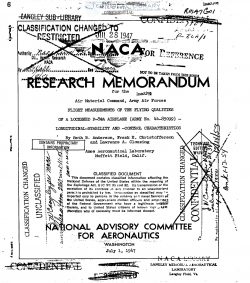naca-rm-a7g01
- Version
- 103 Downloads
- 2.99 MB File Size
- 1 File Count
- April 20, 2017 Create Date
- April 20, 2017 Last Updated
National Advisory Committee for Aeronautics, Research Memorandum - Flight Measurements of the Flying Qualities of a Lockheed P-80A Airplane (Army No.44-85099) - Longitudinal Stability and Control Characteristics

This report contains the flight-test results of the
longitudinal—stability and —control phase of a general flying-
qualities investigation of the Lockheed. P—SOA airplane (Army
He. Alli—85099). The tests were conducted at indicated airspeede
up to 530 miles per hour (0.76 Mach number) at low altitude and
up to 350 miles per hour (0.82 Mach numbér) at high altitude.
These tests showed that the flying qualities of the airplane
were in accordance with the requirements of the Army Air Forces
Stability and Control Specification except for excessive elevator
control forces in maneuvering flight and the inadequacy of the
longitudinal trimming control at low airspeeds.
Flight tests on a Lockheed P—BOA airplane (Army No. hit—85099)
were conducted at the request of the Air Materiel Command, Army Air
Forces, to obtain quantitative measurements of the flying qualities.
This report presents the data obtained during the longitudinal
stability and control tests.
A three—view drawing of the airplane is presented in figure 1
and photographs of the airplane as instrumented for flight tests
are given in figures 2- and 3. The basic dimensions of the airplane
are given in tables I and II. At the normal gross weight of
12, 000 pounds the center-of—gravity range possible in flight is
0.196 to 0.317 N. A. C. A.
The variation of elevator control position with stick movement
(spring tab llocked) for the no—load ground condition, is presented
in figure h. The spring tab had a preload of h pounds and reached
a maximum deflection (22° down) with an elevator control force of
approximately 18 pounds. The combination trim and boost tab on the
elevator had a boost ratio of set/ass = _ 0.33. Figure 5 shows the
variation of elevator control force (bungee effect) with elevator
angle for the static no—load condition. The friction in the elevator—
control system was found to be approximately h pounds as measured
while the control was moved slowly through the neutral position.
| File | Action |
|---|---|
| naca-rm-a7g01 Flight Measurements of the Flying Qualities of a Lockheed P-80A Airplane (Army No.44-85099) -.pdf | Download |

Comment On This Post